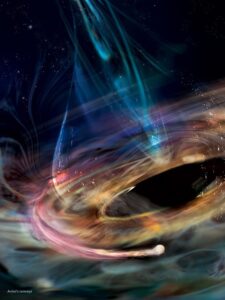AUI will present at the 247th meeting of the American Astronomical Society in Phoenix from January 4-8.
Recent News
ALMA Helps Unmask Monster Black Hole Behind Record-Breaking Cosmic Burst
Astronomers have used the Atacama Large Millimeter/submillimeter Array (ALMA) together with a suite of space- and ground-based telescopes, to study AT 2024wpp, the most luminous fast blue optical transient (LFBOT) ever observed.
Astronomers Make First Radio Detection of Rare Supernova Type, Revealing Secrets of Stellar Death
Astronomers using the U.S. National Science Foundation Very Large Array have captured the first-ever radio signals from a rare class of stellar explosion known as a Type Ibn supernova.
Astronomers Catch Unprecedented Features at Brink of Active Black Hole

In this artist’s concept, a stream of matter trails a white dwarf (sphere at lower right) orbiting within the innermost accretion disk surrounding 1ES 1927’s supermassive black hole. Astronomers developed this scenario to explain the evolution of rapid X-ray oscillations detected by ESA’s (European Space Agency) XMM-Newton satellite. ESA’s LISA mission, due to launch in the next decade, should be able to confirm the presence of an orbiting white dwarf by detecting the gravitational waves it produces. Credit: NASA/Aurore Simonnet, Sonoma State University
The source is 1ES 1927+654, a galaxy located about 270 million light-years away in the constellation Draco. It harbors a central black hole with a mass equivalent to about 1.4 million Suns.
“In 2018, the black hole began changing its properties right before our eyes, with a major optical, ultraviolet, and X-ray outburst,” said Eileen Meyer, an associate professor at UMBC (University of Maryland Baltimore County). “Many teams have been keeping a close eye on it ever since.”
She presented her team’s findings at the 245th meeting of the American Astronomical Society in National Harbor, Maryland. A paper led by Meyer describing the radio results was published Jan. 13 in The Astrophysical Journal Letters.
After the outburst, the black hole appeared to return to a quiet state, with a lull in activity for nearly a year. But by April 2023, a team led by Sibasish Laha at UMBC and NASA’s Goddard Space Flight Center in Greenbelt, Maryland, had noted a steady, months-long increase in low-energy X-rays in measurements by NASA’s Neil Gehrels Swift Observatory and NICER (Neutron star Interior Composition Explorer) telescope on the International Space Station. This monitoring program, which also includes observations from NASA’s NuSTAR (Nuclear Spectroscopic Telescope Array) and ESA’s (European Space Agency) XMM-Newton mission, continues.
The increase in X-rays triggered the UMBC team to make new radio observations, which indicated a strong and highly unusual radio flare was underway. The scientists then began intensive observations using the NSF NRAO’s VLBA and other facilities. The VLBA, a network of radio telescopes spread across the U.S., combines signals from individual dishes to create what amounts to a powerful, high-resolution radio camera. This allows the VLBA to detect features less than a light-year across at 1ES 1927’s distance.
This text is adapted from a press release shared by NASA. Read their complete release.
Access high-resolution versions of these supplemental images in SVS.
About NRAO
The National Radio Astronomy Observatory (NRAO) is a facility of the U.S. National Science Foundation, operated under cooperative agreement by Associated Universities, Inc.
Original release text by Francis Reddy
NASA’s Goddard Space Flight Center, Greenbelt, Md.
Media Contacts:
Claire Andreoli
301-286-1940
[email protected]
Public Affairs Officer
NASA’s Goddard Space Flight Center, Greenbelt, Md.
Jill Malusky
304-456-2236
[email protected]
News & Public Information Manager
National Radio Astronomy Observatory, Charlottesville, Va.
Corrina Jaramillo Feldman
505-366-7267
[email protected]
Public Information Officer – New Mexico
National Radio Astronomy Observatory, Socorro, NM.
This news article was originally published on the NRAO website on January 13, 2025.
Recent News
AUI to Attend AAS 247 Conference
AUI will present at the 247th meeting of the American Astronomical Society in Phoenix from January 4-8.
ALMA Helps Unmask Monster Black Hole Behind Record-Breaking Cosmic Burst
Astronomers have used the Atacama Large Millimeter/submillimeter Array (ALMA) together with a suite of space- and ground-based telescopes, to study AT 2024wpp, the most luminous fast blue optical transient (LFBOT) ever observed.
Astronomers Make First Radio Detection of Rare Supernova Type, Revealing Secrets of Stellar Death
Astronomers using the U.S. National Science Foundation Very Large Array have captured the first-ever radio signals from a rare class of stellar explosion known as a Type Ibn supernova.
